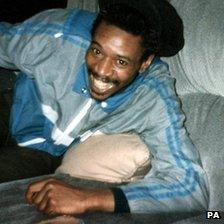The troubling secrets of England’s mental hospitals
- Published
- comments
Sheffield Mental Health Trust's Prof Tim Kendall stopped the use of face-down restraint after experiencing it himself
Perhaps even more disturbing than what we now know about the "excessive" use of face-down restraint inside some English mental hospitals is what we don't know.
Six of the 54 mental health trusts replied to a Freedom of Information request saying they could not say how often any form of restraint was used. Half of them could not provide details of how often their staff had used the controversial and dangerous face-down technique.
Under the Mental Health Act 1983, institutions are statutorily obliged to "document and review every episode of physical restraint which should include a detailed account of the restraint".
The Health Minister Norman Lamb is concerned that such partial records of these traumatic and potentially lethal procedures are available. "We just don't know enough about what goes on in mental health, how resources are used, what the practices are and that needs to change," he told me.
I understand he has asked officials to look at demanding all trusts openly publish the details of all restraint and seclusion they use. The secrecy that surrounds mental health remains deeply troubling.

David Bennett died in 1998 after being restrained at a Norwich clinic
However, ministers and NHS England have questions to answer:
Why did it take an independent charity, Mind, to reveal the variation in the use of restraint and the yawning gaps in the available data?
Who is policing the law in this area?
What happens to all the "reviews" and documentation that supposedly follow each of the tens of thousands of restraint incidents conducted each year?
A spokesperson for NHS England tells me that the issue of restraint is "a priority" and work is underway to identify the best policies and practices to minimise its use.
But it is almost 15 years since a government-commissioned independent inquiry into the death of David "Rocky" Bennett, external demanded almost exactly that.
"This is another example of the lack of parity of esteem between mental health and physical health," Mr Lamb says.
It is hard not to agree.